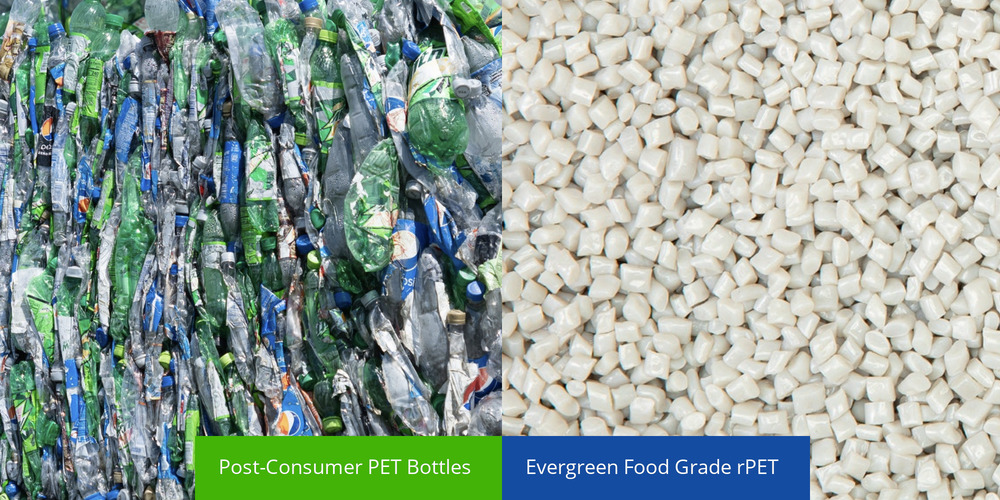Updated Jan 2024
Evergreen Albany’s Brian O’Clair, is a chemist and Quality, Safety and Environmental Manager who has worked in PET plastics recycling for 36 years.
EBT: How did you get into plastics recycling? Was it your dream job?
BOC: I didn’t set out to be in plastics recycling; it’s a career that found me. In college, I started in Chemical Engineering, flirted with the idea of Computer Science and finished with a degree in Chemistry.
 One of my first jobs was with the Star Textile and Research Company in Albany as a quality control technician. When the textile business relocated to the Carolinas, Star purchased a cleaning line for recycling and changed its name to Star Plastics. I went from a chemist running textiles tests to doing plastics recycling and cleaning tests. Ultimately, I developed operational and quality standards for PET plastic recycling. For the company and the industry at large. Here’s what’s interesting, while I never changed jobs, the company I worked for kept changing. Star Plastics was acquired by Wte in 1990, which did a joint venture in 2000 that created UltrePET, and then in December 2021, UltrePET was acquired by Evergreen. I had no idea I’d make plastics recycling my career, but it has become my dream job.
One of my first jobs was with the Star Textile and Research Company in Albany as a quality control technician. When the textile business relocated to the Carolinas, Star purchased a cleaning line for recycling and changed its name to Star Plastics. I went from a chemist running textiles tests to doing plastics recycling and cleaning tests. Ultimately, I developed operational and quality standards for PET plastic recycling. For the company and the industry at large. Here’s what’s interesting, while I never changed jobs, the company I worked for kept changing. Star Plastics was acquired by Wte in 1990, which did a joint venture in 2000 that created UltrePET, and then in December 2021, UltrePET was acquired by Evergreen. I had no idea I’d make plastics recycling my career, but it has become my dream job.
EBT: What were the early days of plastics recycling like?
BOC: (Laughs) No one really knew what they were doing in the late 1980s and early 90s. We (Star and later Wte) had a wash line and started there. That was back in the days when the two-liter PET soda bottles had an HDPE base. We’d separate the PET and HDPE, wash the PET, and make flake. It had label in it and was wet. We’d try to sell it and buyers would say, “We’d take it if it were dry.” So we bought a dryer. Buyers would then say, “We’d take it if it didn’t have dust bunnies.” So we added an aspirator. It seemed like we were always sticking another machine on our line. It’s funny, but true!
At the time, no one was doing bottle-to-bottle recycling. We were strictly non-food grade rPET. Our resin was pretty rough by today’s standards but companies like DuPont bought it for engineered resin for automotive parts. We also sold rPET to thermoformers for sheets and if it were clear enough, it went into vacuum-molded clamshells. The green rPET went to strapping companies .
EBT: It sounds kind of like the wild, wild west. When did plastics recycling, particularly PET recycling, come into its own?
BOC: Setting standards for recycled material is complicated because of the variability of the base materials; there is no way to totally control it. In the industry’s early days, chemists like me and engineers got together and began working on standards. When the Association of Plastics Recyclers (APR) was created, that was a big win because activities around standards were formalized and there was input from a wide range of people and companies. I’ve been involved with APR for the past several decades, contributing to critical guidance for the plastics recycling industry and currently serve on the APR Technical Committee.
One of the exciting things we achieved was publishing the APR Design™ Guide, which is the resource on plastics recycling by resin and how to design products and packaging for recycling. Just because something is made of PET doesn’t mean it’s easily recyclable. For example, some oxygen scavengers, if not properly designed for recyclability, can discolor during the heat of reprocessing. Paper labels can bleed ink into the bottle, which screws up the resin. Then there’s the question: is the package “friendly” to collection points and processors? If not, it will never be food grade. The APR Design Guide is an extremely helpful technical resource for the industry, innovators, engineers, and brands that want to close the loop on plastics recycling.
EBT: Why is it so difficult to produce food grade rPET?
BOC: The ultimate goal is to produce recycled PET resin that behaves like virgin resin and meets the FDA’s Non-Objection Letter (NOL) requirements. There are a number of things that make it hard to do: quality of the feedstock, which varies widely; the sophistication of the required processing, quality testing, and the expertise of those doing the processing. You’ve got to have all of those things plus meet a customer’s specs and pass the regulatory folks. It’s really, really difficult to do. But there’s a reason for setting high bars: rPET suppliers and the brands can’t afford problems. You have to be really good to get food grade rPET right.
EBT: Evergreen currently collects and recycles some 11.6 billion post-consumer PET bottles a year and we need more to meet the demand for food grade rPET. Where are we going to get them?
BOC: First, it’s important to understand all post-consumer PET bottles are not created equal. The labels are different, the glues are different, the caps are different. And they’re collected in different ways. To produce the highest grades of rPET, we have to reach a critical mass of consistent, high-quality feedstock. It’s a struggle because bale quality varies widely. A hundred million pounds of bottles doesn’t mean you’re going to get 100 million pounds of food grade rPET. In an ideal world, the best way to increase bottle collections and get consistent, high-quality bales is to change our recycling collection system to require deposits on PET bottles. As an example, Michigan requires a ten-cent per bottle deposit and as a result, their reclamation rate is around 90 percent.
EBT: What projects are you working on now?
BOC: Since Evergreen now has three PET recycling and rPET manufacturing plants plus a fourth focused on recycling – see all Evergreen locations here – we’re focused on standardizing our recycling, manufacturing, and quality processes across the organization. This is a huge opportunity for the company and especially for our customers. We have people who are truly experts when it comes to recycling and rPET. I like to call this group the “recycling gurus” because there’s so much to learn from our collective knowledge. We’re sharing our knowledge to create best practices, which means that going forward, customers will be confident of receiving the same high quality, food grade rPET from Evergreen regardless of the plant of origin. That’s extremely important to brands.
